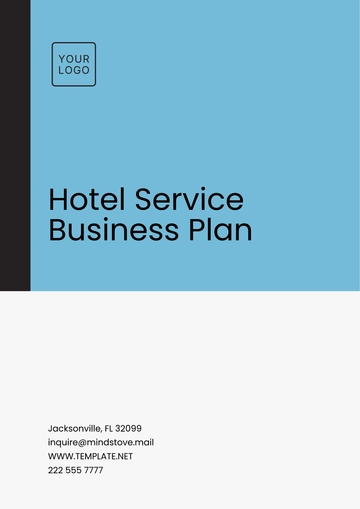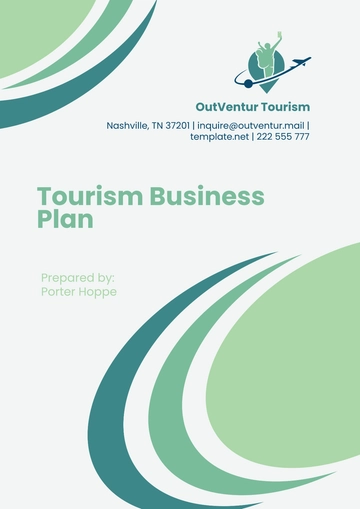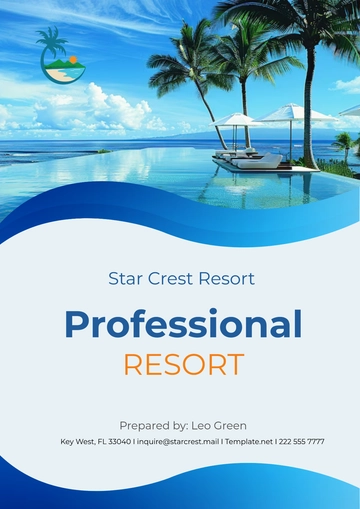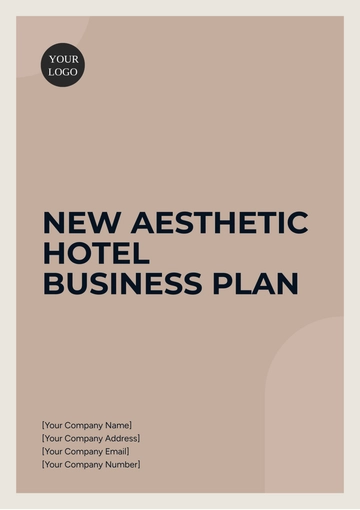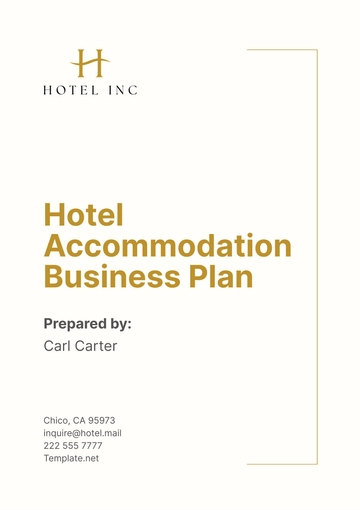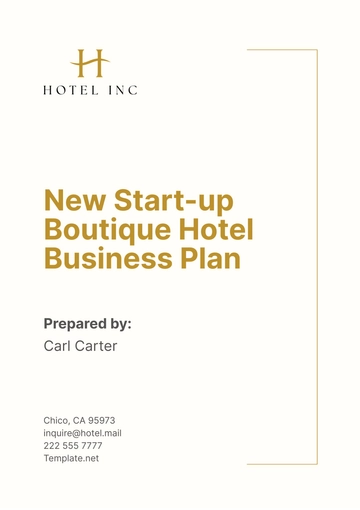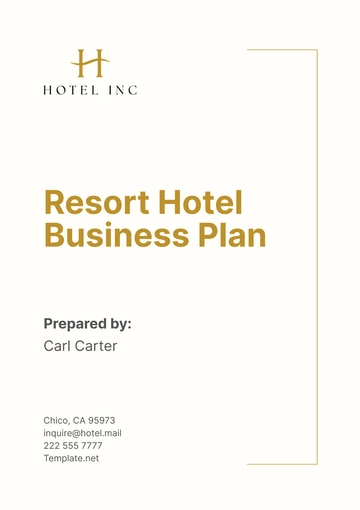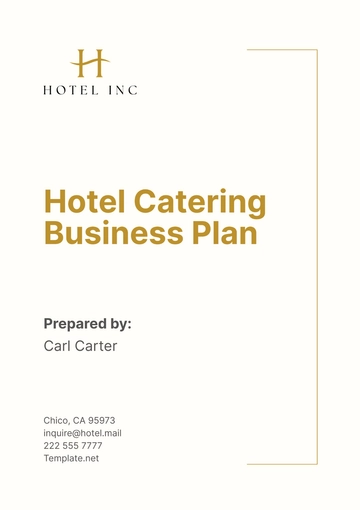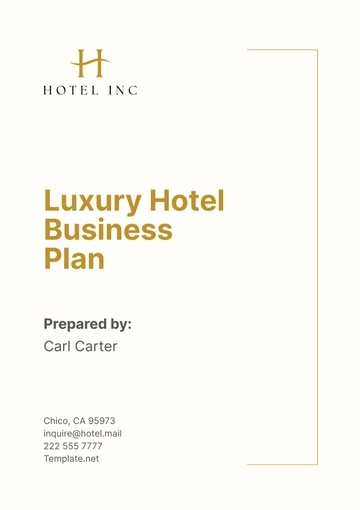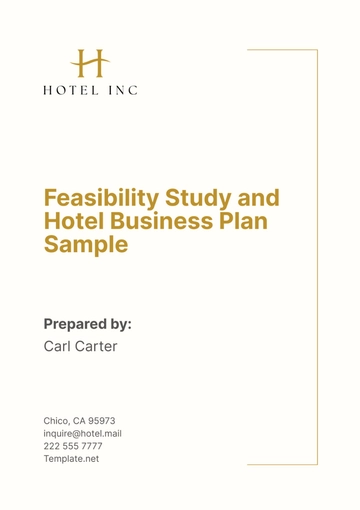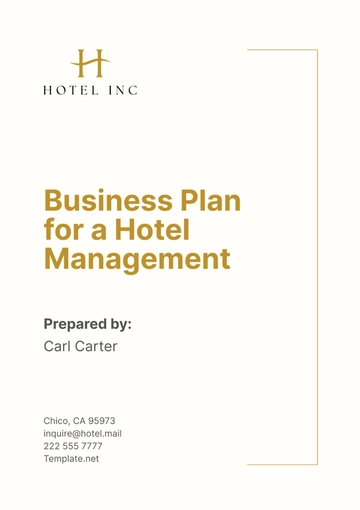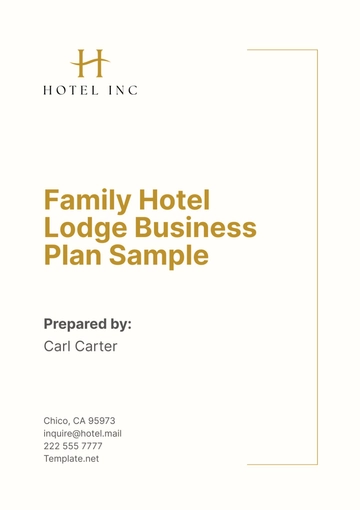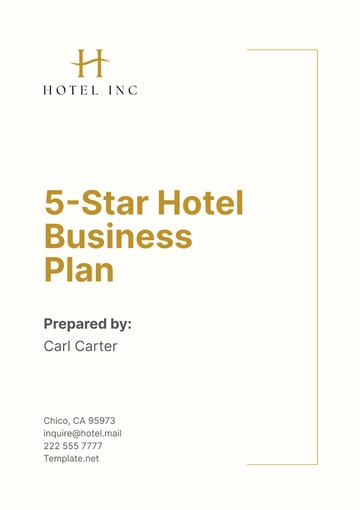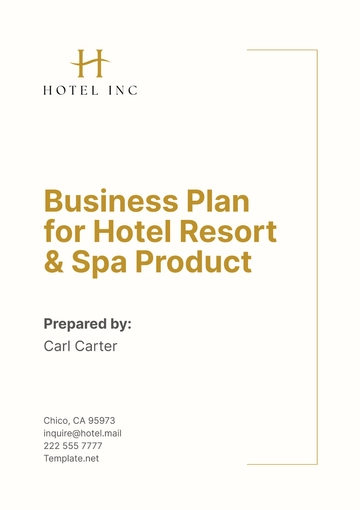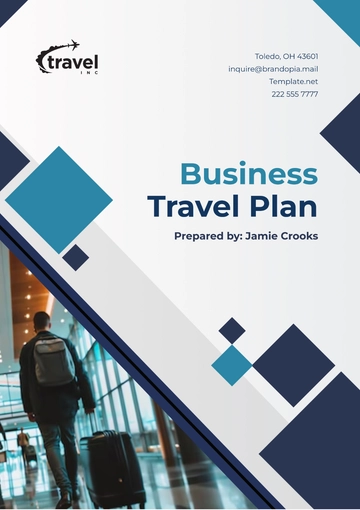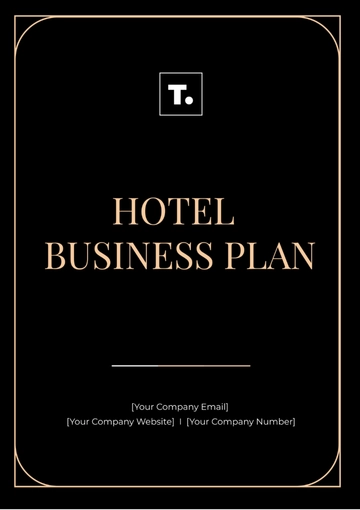Free Resort Business Plan
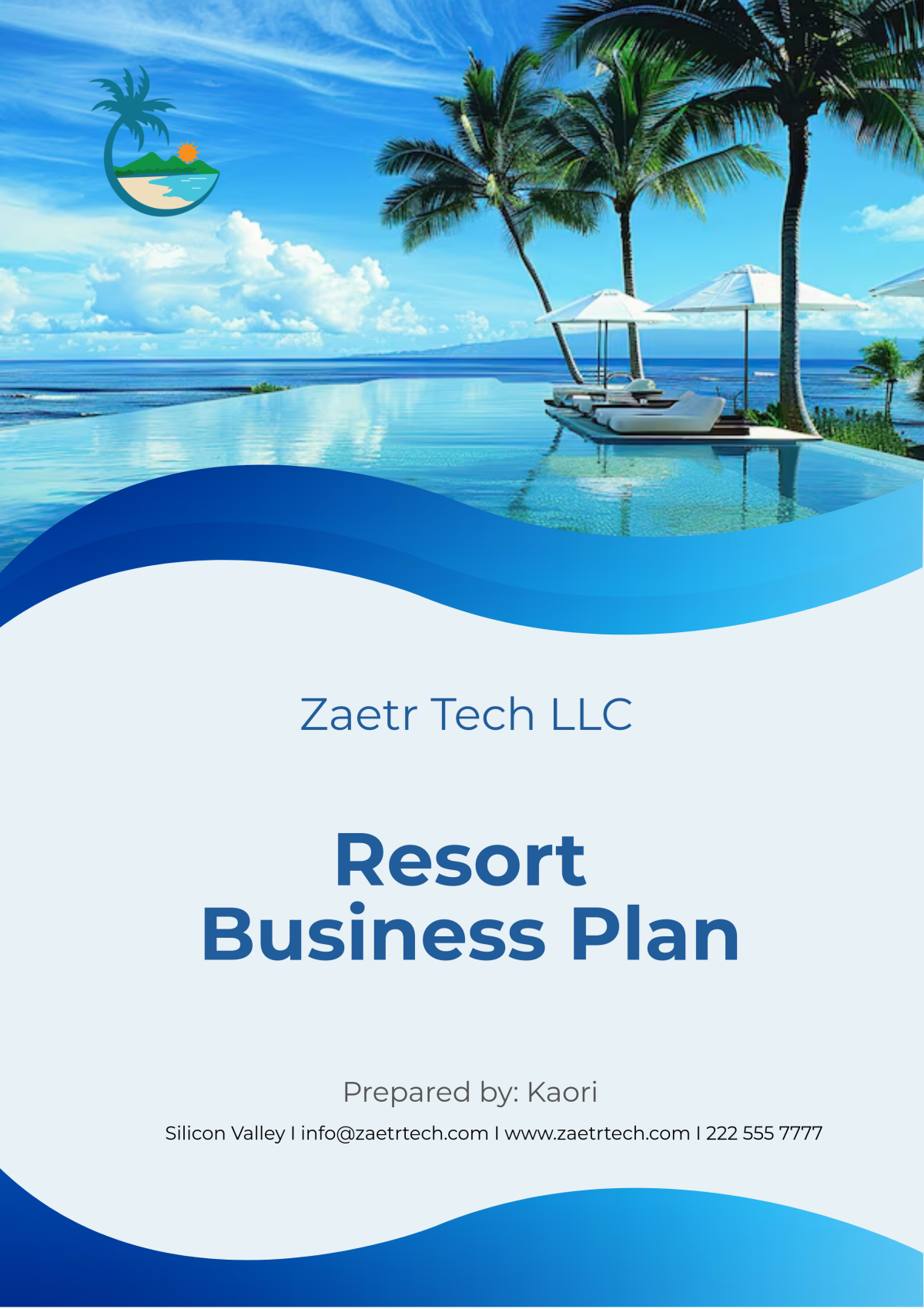
I. Executive Summary
A. Business Overview
[Your Company Name], set to open in 2050, will be a premier luxury resort situated in the picturesque region of [Your Company Address]. This idyllic location has been meticulously chosen for its stunning natural beauty, accessibility, and rich cultural heritage, offering guests an unparalleled escape from the everyday. Our resort will provide an unmatched experience by combining world-class amenities, superior customer service, and a pristine natural environment. Catering to high-end tourists and business travelers seeking a unique blend of relaxation, adventure, and exclusivity, our primary objective is to establish [Your Company Name] as the top destination in the region by leveraging sustainable practices and creating unforgettable experiences for our guests.
The resort will feature [150] accommodations, including [30] luxury suites and [20] private villas, alongside multiple fine-dining restaurants, a wellness spa, and a variety of recreational facilities, such as a [9-hole] golf course, tennis courts, water sports, and guided nature tours. Each aspect of the resort has been carefully designed to ensure comfort, relaxation, and enjoyment, allowing guests to create lasting memories. The combination of these amenities will create an oasis of comfort and adventure for our guests, ensuring they return time and again.
B. Mission Statement
The mission of [Your Company Name] is to deliver a luxurious and eco-friendly resort experience while promoting sustainable tourism. We aim to blend the serenity of nature with top-tier service and world-class facilities, ensuring that guests leave with memorable experiences while minimizing our ecological footprint. Our commitment to excellence and sustainability will resonate with our guests, allowing them to indulge in luxury without compromising their values.
C. Vision Statement
By 2060, [Your Company Name] will be recognized as one of the leading eco-luxury resorts in the world. We aim to continuously improve our services, expand our global reputation, and set the standard for sustainable tourism. Our vision is not just to provide luxury but to redefine what it means to enjoy a high-end getaway in harmony with nature.
D. Financial Overview
We anticipate a startup cost of approximately $[10,000,000], which includes construction, initial operational costs, and marketing expenses. This investment will cover everything from high-quality construction materials to sophisticated marketing campaigns that will position [Your Company Name] as the premier resort in the region. Projected annual revenue in the first year of operation is $[5,000,000], with an anticipated profit margin of [30]%. The break-even point is expected within [3] years, and long-term profitability will be driven by high occupancy rates, premium services, and diversified revenue streams. Our financial strategy emphasizes sustainability, aiming for a solid return on investment while maintaining our commitment to eco-friendly practices.
II. Resort Concept and Design
A. Resort Concept
[Your Company Name] will provide a blend of modern luxury with nature. The concept focuses on offering an all-inclusive experience, combining relaxation, adventure, and wellness. The resort will be themed to reflect the local culture and natural beauty, while the architecture will incorporate sustainable design elements such as solar power, rainwater harvesting, and energy-efficient systems. The design will utilize local materials and labor, enhancing community involvement and ensuring that our presence positively impacts the region.
1. Luxury Accommodations
The resort will feature [150] rooms, ranging from standard luxury suites to private, exclusive villas. Each room will be designed to provide an immersive experience, adorned with local art and natural materials that reflect the surrounding environment. Every accommodation will include state-of-the-art amenities, such as smart home technology, private terraces with breathtaking views, and high-speed internet access. For guests seeking ultimate privacy, the resort will offer high-end villas with private pools and dedicated concierge services, ensuring that all their needs are met promptly and efficiently.
Room Types and Features
Room Type | Number of Rooms | Amenities | Estimated Rate per Night ($) |
|---|---|---|---|
Luxury Suites | 30 | King-size bed, private terrace, sea view | 500 |
Private Villas | 20 | Private pool, kitchen, butler service | 1,200 |
Standard Rooms | 80 | Queen bed, en-suite bathroom, balcony | 350 |
Family Suites | 20 | Two bedrooms, kitchenette, family-friendly | 600 |
2. Restaurants and Dining
The resort will house [4] gourmet restaurants, offering an array of local and international cuisine. Our signature restaurant, Ocean’s Essence, will provide fine dining in an exquisite setting, utilizing fresh, locally sourced ingredients. A beachside grill, The Sunset Grill, and a casual café, The Coffee House, will cater to guests seeking a more relaxed dining experience, while in-room dining will be available for all guests. We will also host themed dining events, featuring local chefs and culinary experiences that allow guests to immerse themselves in the local culture.
Dining Options
Restaurant Name | Cuisine Type | Dining Style | Estimated Average Meal Cost ($) |
|---|---|---|---|
Ocean’s Essence | Seafood | Fine Dining | 75 |
The Green Fork | Farm-to-Table | Casual | 30 |
Sunset Grill | International | Outdoor Dining | 50 |
The Coffee House | Café & Bakery | Casual | 10 |
3. Wellness and Spa Facilities
The wellness spa will be an integral part of the resort experience. Offering a variety of treatments, including massages, facials, and holistic therapies, the spa will promote relaxation and rejuvenation. Each treatment will be tailored to the guest’s preferences, incorporating local herbal remedies and organic products. The resort will also feature a fully equipped fitness center, yoga studio, and outdoor wellness activities such as meditation sessions and guided nature walks. Wellness retreats will be offered regularly, allowing guests to immerse themselves in health-focused programs designed to rejuvenate the mind and body.
Sample Spa Treatments and Pricing
Treatment | Duration | Price ($) |
|---|---|---|
Swedish Massage | [60 minutes] | [120] |
Facial Treatment | [60 minutes] | [90] |
Holistic Therapy | [90 minutes] | [150] |
Yoga Class | [60 minutes] | [25] |
4. Recreation and Adventure
[Your Company Name] will provide a wide range of recreational activities, appealing to both adventure seekers and those seeking relaxation. Water sports, including kayaking, snorkeling, and diving, will be available for guests, while the surrounding natural areas will offer hiking trails, bird watching, and cultural tours. In addition to outdoor adventures, the resort will host cultural events, such as local music and dance performances, showcasing the rich heritage of the region. Additional facilities include tennis courts, a [9-hole] golf course, and a resort-managed marina for yacht docking, ensuring that guests have access to activities that cater to all interests.
B. Sustainable Design and Eco-Friendly Initiatives
Sustainability will be a key pillar of [Your Company Name]'s design. The resort will employ eco-friendly building materials, solar-powered energy systems, and rainwater harvesting to reduce our environmental impact. Our commitment to sustainability extends beyond construction; we will implement practices such as organic gardening, waste management programs, and biodiversity conservation efforts to protect the local ecosystem. Educational programs for guests will emphasize the importance of sustainability and how they can contribute to these efforts during their stay.
Key Sustainable Practices
Initiative | Description |
|---|---|
Solar Power Systems | Harnessing solar energy to power resort operations |
Rainwater Harvesting | Collecting rainwater for irrigation and non-potable use |
Organic Gardens | Growing organic produce for our restaurants |
Eco-Conscious Guest Programs | Offering activities that promote environmental stewardship |
III. Market Research and Target Audience
A. Market Analysis
The global luxury travel market is projected to grow at an annual rate of [5%] between 2050 and 2060, driven by increasing disposable income, rising travel demand from emerging economies, and a growing emphasis on experiential travel. As people increasingly prioritize experiences over material possessions, the demand for high-quality, immersive vacations continues to rise. In particular, the trend toward eco-tourism and sustainable luxury travel is expected to grow significantly in the coming decade. [Your Company Name] is well-positioned to capitalize on these trends with its focus on sustainability and high-end offerings, catering to a growing market of conscious consumers who seek luxurious yet environmentally responsible travel options.
B. Competitor Analysis
In the surrounding region, there are a number of established luxury resorts. However, [Your Company Name] will differentiate itself through its commitment to sustainability, its exclusive location, and the range of activities offered. Our unique selling propositions (USPs) include our extensive wellness programs, locally inspired culinary experiences, and personalized guest services. Key competitors include:
[Competitor 1]: Offers luxury accommodations but lacks a strong focus on sustainability. They have not adopted eco-friendly practices, which could be a deciding factor for environmentally-conscious travelers.
[Competitor 2]: Provides a wide range of activities but is not as exclusive in terms of location. Their larger scale may lead to a more crowded experience, which could deter guests seeking solitude and personalized service.
[Competitor 3]: High-end service but smaller range of amenities. They lack the extensive wellness offerings that [Your Company Name] will provide, allowing us to appeal to health-conscious guests.
C. Target Audience
High-Net-Worth Individuals: Seeking exclusive experiences and privacy, this segment will be targeted through personalized packages and services that cater to their unique preferences.
Corporate Clients: Businesses looking for off-site retreats and team-building activities will be approached with tailored packages that emphasize productivity and relaxation.
Honeymooners and Couples: Romantic getaways and honeymoon experiences will be targeted through specialized packages that include private dinners, spa treatments, and secluded accommodations.
Eco-Conscious Travelers: An increasing number of travelers are looking for eco-friendly options that align with their values. Our commitment to sustainability will appeal to this demographic, ensuring they can enjoy luxury while minimizing their impact on the environment.
D. Target Audience Characteristics
Segment | Demographics | Interests |
|---|---|---|
High-net-worth individuals | Ages [35-65], high income | Luxury experiences, privacy, exclusivity |
Corporate clients | Business professionals, companies | Team-building, networking, retreats |
Honeymooners and couples | Ages [25-40], newlyweds | Romantic getaways, unique experiences |
Eco-conscious travelers | All ages, environmentally aware | Sustainability, eco-tourism, local culture |
IV. Marketing Strategy
A. Branding Strategy
The brand identity of [Your Company Name] will reflect our commitment to luxury, sustainability, and personalized service. Our logo and visual elements will incorporate natural motifs and colors that resonate with the surrounding environment, reinforcing our connection to nature. The brand will emphasize exclusivity and eco-conscious luxury, appealing to travelers who prioritize both comfort and environmental responsibility. Messaging will focus on the unparalleled experiences available at our resort, including exceptional service, unique activities, and sustainability initiatives.
B. Promotional Strategy
A multi-channel marketing strategy will be employed to reach our target audience effectively. This will include:
Digital Marketing: A strong online presence through a user-friendly website, active social media engagement, and targeted online advertising campaigns. Content marketing will showcase the resort's unique offerings, highlighting guest experiences, sustainable practices, and local attractions.
Partnerships with Travel Influencers: Collaborating with luxury travel influencers to promote the resort through authentic content, including reviews, blog posts, and social media features. This strategy will leverage the influencers' audiences to generate interest and increase brand awareness.
Trade Shows and Industry Events: Participating in luxury travel expos, trade shows, and industry events to network with travel agents, corporate clients, and potential guests. These events will allow us to showcase our unique offerings and establish relationships with key stakeholders in the luxury travel market.
Public Relations: Developing relationships with travel magazines and blogs for feature articles and press releases to share our story and promote the unique aspects of [Your Company Name]. We will focus on securing coverage in publications that cater to luxury and eco-conscious travel.
C. Pricing Strategy
Pricing will be strategically aligned with the luxury market while also reflecting our commitment to sustainability. Rates will be competitive with other high-end resorts while offering exclusive packages that provide value. Pricing will include options for all-inclusive packages, honeymoon specials, and corporate retreat deals. Seasonal pricing will also be employed to maximize occupancy during peak travel times.
Sample Pricing Structure
Package Type | Price | Inclusions |
|---|---|---|
Standard Room (per night) | $350 | Breakfast, access to amenities |
Luxury Suite (per night) | $500 | Breakfast, spa credits, access to all facilities |
Private Villa (per night) | $1,200 | All-inclusive meals, private concierge service |
Honeymoon Package | $1,800 | Romantic dinner, couples massage, wine on arrival |
V. Operational Plan
A. Organizational Structure
The organizational structure of [Your Company Name] will be designed to promote efficiency, accountability, and exceptional service. Key management roles will include:
General Manager: Responsible for overall operations, financial management, and guest satisfaction. The General Manager will lead the team, set performance goals, and ensure that the resort meets its financial targets.
Director of Sales and Marketing: Overseeing all marketing and sales efforts, including digital marketing, public relations, and partnerships. This role will focus on driving occupancy and revenue through effective promotional strategies.
Food and Beverage Manager: Responsible for the culinary team and dining operations. The Food and Beverage Manager will ensure that all dining experiences meet our high standards of quality and service.
Spa and Wellness Director: Overseeing the spa and wellness programs, ensuring that guests receive top-quality treatments and services. This role will also focus on developing new wellness offerings based on guest feedback and trends.
Operations Manager: Responsible for daily operations, including housekeeping, maintenance, and guest services. The Operations Manager will ensure that all areas of the resort run smoothly and that guests receive prompt assistance.
Organizational Chart
Position | Responsibilities |
|---|---|
General Manager | Overall management and financial oversight |
Director of Sales and Marketing | Marketing strategies and revenue generation |
Food and Beverage Manager | Culinary operations and guest dining |
Spa and Wellness Director | Wellness offerings and spa management |
Operations Manager | Daily operations and guest services |
B. Staffing Plan
The staffing plan will focus on recruiting experienced professionals who share our commitment to excellence and sustainability. We will employ approximately [120] staff members across various departments, ensuring that we maintain a high staff-to-guest ratio for personalized service. Training programs will emphasize the importance of sustainability and guest experience, creating a team that is knowledgeable, motivated, and dedicated to providing outstanding service.
Staffing Requirements
Department | Number of Staff | Key Roles |
|---|---|---|
Front Desk | 15 | Receptionists, concierge |
Food and Beverage | 40 | Chefs, servers, bartenders |
Housekeeping | 25 | Housekeepers, laundry staff |
Spa and Wellness | 10 | Therapists, fitness instructors |
Management | 10 | Department heads and supervisors |
Maintenance | 10 | Maintenance staff, gardeners |
C. Facilities Management
Facilities management will be crucial in ensuring that all resort areas are maintained to the highest standards. Regular inspections and maintenance schedules will be implemented for all facilities, including guest rooms, restaurants, recreational areas, and spa facilities. Additionally, sustainability practices will be integrated into operations, including energy management systems, waste reduction programs, and routine checks on eco-friendly systems.
Maintenance Schedule
Facility | Maintenance Frequency | Responsibility |
|---|---|---|
Guest Rooms | Daily | Housekeeping staff |
Restaurants | Daily | Food and Beverage Manager |
Spa Facilities | Weekly | Spa and Wellness Director |
Recreational Areas | Monthly | Operations Manager |
Grounds | Weekly | Maintenance Staff |
VI. Financial Plan
A. Startup Costs
To establish [Your Company Name], we project the following startup costs:
Cost Category | Estimated Cost |
|---|---|
Land acquisition | $3,000,000 |
Construction and design | $5,000,000 |
Furnishings and equipment | $1,500,000 |
Initial marketing and branding | $500,000 |
Staffing and training | $500,000 |
Operating capital | $1,500,000 |
Total Estimated Startup Costs | $12,000,000 |
This budget will cover all aspects of development, from land acquisition to initial marketing campaigns. Our detailed financial strategy will ensure that we remain within budget while delivering a resort that exceeds guest expectations.
B. Revenue Projections
Revenue projections are based on anticipated occupancy rates, average daily rates, and additional services offered at the resort. The following table outlines our expected revenue for the first five years:
Year | Projected Revenue | Occupancy Rate | Average Daily Rate |
|---|---|---|---|
2050 | $5,000,000 | 60% | $400 |
2051 | $7,000,000 | 75% | $450 |
2052 | $9,000,000 | 80% | $500 |
2053 | $11,000,000 | 85% | $550 |
2054 | $13,000,000 | 90% | $600 |
Total (First 5 years) | $45,000,000 |
These projections are conservative estimates, and we expect that strong marketing efforts, coupled with exceptional guest experiences, will drive higher occupancy rates and increased revenue over time.
C. Break-Even Analysis
To determine our break-even point, we will analyze our fixed and variable costs, along with our projected revenue. The following table summarizes the necessary calculations:
Cost Type | Annual Cost |
|---|---|
Fixed Costs (salaries, utilities, insurance) | $1,500,000 |
Variable Costs (supplies, maintenance, marketing) | $2,500,000 |
Total Annual Costs | $4,000,000 |
To calculate the break-even point:
Average Revenue per Room (ARR): $[400]
Occupancy Rate: [60%]
Total Rooms: [150]
Total Available Room Nights (TARN): [150 x 365] = [54,750]
Total Revenue Calculation:
Total Revenue = TARN × ARR × Occupancy Rate
Total Revenue = 54,750 × 400 × 0.60 = 13,110,000
The break-even point is achieved when total revenue equals total costs:
Break-even Point= Total Annual Costs / ARR×Occupancy Rate = 4,000,000 / 400×0.60
= 16.67 rooms sold per night
The break-even point will be reached once we sell approximately [17] rooms per night, which is a realistic target given our projected occupancy rates.
D. Funding Requirements
To finance the startup costs and initial operations of [Your Company Name], we are seeking a total investment of $[12,000,000]. Funding will be sourced from a combination of:
Equity Investment: $[6,000,000] from private investors and venture capitalists interested in the luxury and eco-tourism sectors.
Bank Loans: $[4,000,000] in loans from financial institutions with favorable terms for the hospitality industry.
Personal Contributions: $[2,000,000] from the founders and key stakeholders, demonstrating commitment and confidence in the project.
VII. Risk Analysis
A. Potential Risks
Economic Downturn: Changes in economic conditions can significantly impact travel and tourism, leading to decreased occupancy rates.
Environmental Risks: Natural disasters, climate change, or adverse weather conditions can affect resort operations and guest experiences.
Regulatory Risks: Changes in local laws and regulations regarding environmental practices and tourism can impose additional costs or restrictions.
Competition: Increasing competition in the luxury resort market can affect pricing and occupancy rates.
Operational Risks: Staff turnover, operational inefficiencies, or failure to meet guest expectations can lead to negative reviews and impact revenue.
B. Mitigation Strategies
To address these risks, we will implement several strategies:
Diverse Marketing Strategies: Developing a diversified marketing plan that includes targeting different demographics will help mitigate the impact of economic downturns.
Insurance Coverage: Comprehensive insurance policies will protect against property damage, business interruptions, and liability claims.
Regular Training Programs: Ongoing staff training and development will ensure that all team members are equipped to handle challenges effectively, promoting a culture of excellence.
Continuous Monitoring: Regular assessments of market trends and regulatory changes will allow us to adjust our strategies proactively and maintain compliance.
Emergency Preparedness Plans: Establishing emergency response plans will ensure the safety of guests and staff, minimizing the impact of potential environmental risks.
- 100% Customizable, free editor
- Access 1 Million+ Templates, photo’s & graphics
- Download or share as a template
- Click and replace photos, graphics, text, backgrounds
- Resize, crop, AI write & more
- Access advanced editor
Establish a successful resort with the Resort Business Plan Template from Template.net. This editable and customizable template helps you outline your business goals, market strategies, and financial projections effectively. Use our Ai Editor Tool to personalize it, ensuring your plan reflects your unique vision for a thriving resort.
You may also like
- One Page Business Plan
- Coffee Shop Business Plan
- Restaurant Business Plan
- Food Business Plan
- Real Estate Business Plan
- Executive Summary Business Plan
- Cover Page Business Plan
- Nonprofit Business Plan
- Daycare Business Plan
- Construction Business Plan
- Startup Business Plan
- Medical Business Plan
- Bakery Business Plan
- Service Plan
- Hotel Business Plan
- Catering Business Plan
- School Business Plan
- Healthcare Business Plan
- Transportation Plan
- Sports Plan
- Car Wash Business Plan
- Salon Business Plan
- Clothing Business Plan
- Farming Business Plan
- Boutique Plan
